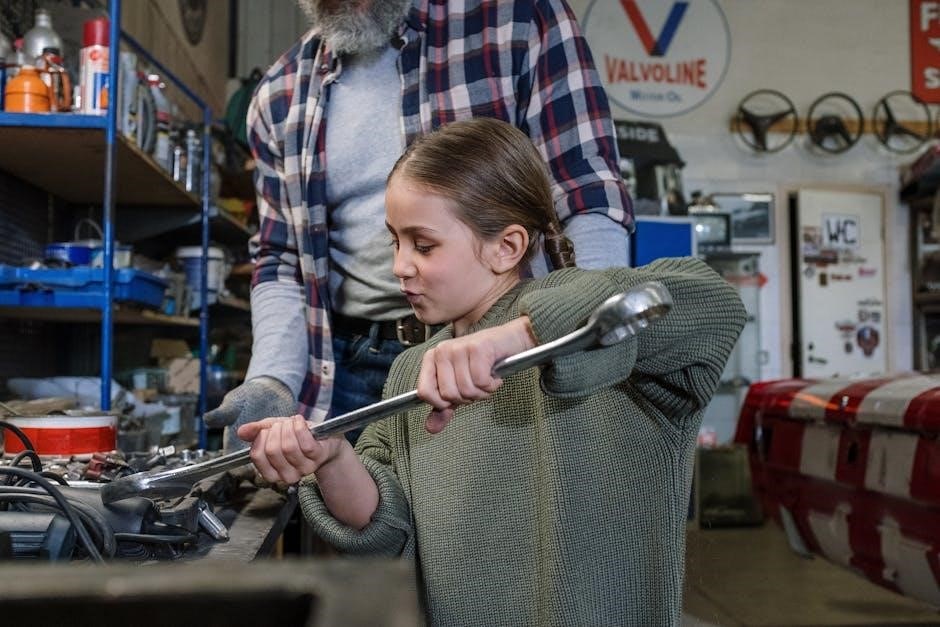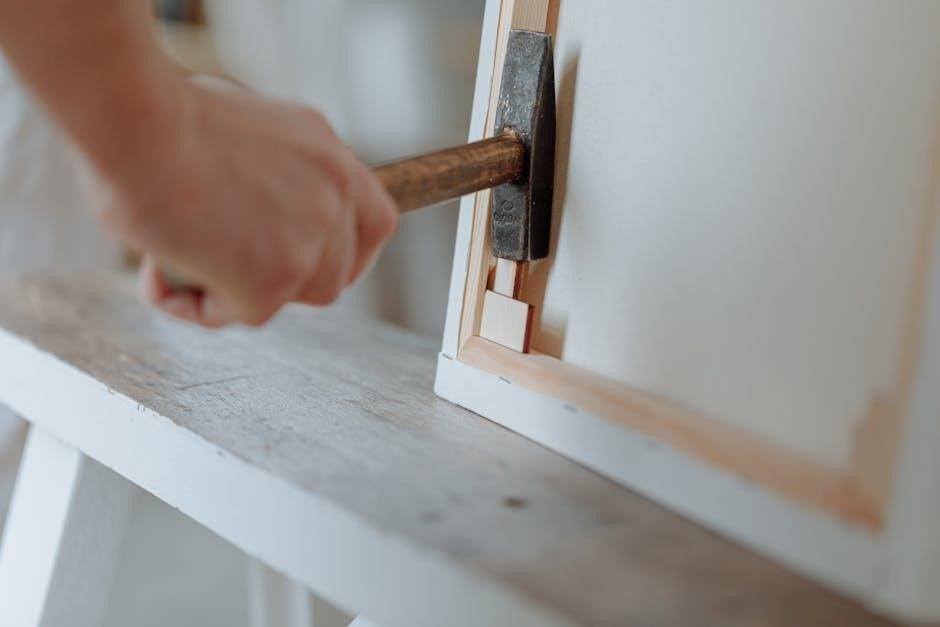Welcome to the EW-36 Mobility Scooter Repair Manual, your comprehensive guide for maintaining and repairing your scooter. This manual covers essential tools, troubleshooting, and step-by-step repair processes, ensuring optimal performance for all users.
1.1 Importance of the Repair Manual
The EW-36 Mobility Scooter Repair Manual is an indispensable resource for both users and technicians. It provides detailed instructions for troubleshooting, maintenance, and repairs, ensuring the scooter operates safely and efficiently. Regular use of this manual helps extend the scooter’s lifespan, prevent costly repairs, and maintain optimal performance. By following the guidelines, users can address common issues promptly, reducing downtime and enhancing overall reliability. This manual is particularly valuable for DIY enthusiasts and professionals alike, as it offers step-by-step solutions and essential insights into the scooter’s electrical and mechanical systems. Adhering to the manual’s recommendations ensures adherence to manufacturer standards, guaranteeing safety and longevity for the EW-36 model.
1.2 Brief Overview of the EW-36 Model
The EW-36 mobility scooter is a high-performance, recreational scooter designed for comfort and reliability. It features a robust frame, sturdy construction, and a powerful electrical system. With a top speed of 18 mph and a range of up to 45 miles on a single charge, this scooter is ideal for both short and long-distance trips. Its heavy-duty design supports a weight capacity of 500 lbs, making it suitable for a wide range of users. The scooter is equipped with advanced features such as a voltmeter, a comfortable seating system, and a user-friendly control panel. Its sleek design and durable components ensure years of reliable service when properly maintained. This model is popular among seniors, outdoor enthusiasts, and individuals requiring mobility assistance, offering a perfect blend of power, stability, and ease of use.
1.3 Safety Precautions Before Starting Repairs
Before starting any repairs on the EW-36 mobility scooter, ensure your safety and the integrity of the scooter. Always disconnect the battery to avoid accidental start-ups or electrical shocks. Wear protective gear, including gloves and safety glasses, to prevent injuries. Ensure the scooter is on a stable, flat surface and apply the parking brake. Avoid wearing loose clothing or jewelry that could get caught in moving parts. Keep the work area well-ventilated and free from flammable materials. Never attempt repairs while the scooter is in operation or under power. If uncertain about a procedure, consult the official repair manual or contact a professional technician. Safety should always be your top priority to prevent accidents and ensure successful repairs.

Understanding the Electrical System of the EW-36
The EW-36’s electrical system includes a battery, motor, controller, and wiring. Monitoring voltage levels is crucial, as excessive sag indicates a depleted or damaged battery, requiring immediate attention.
2.1 Battery Maintenance and Troubleshooting
The EW-36 mobility scooter’s battery is a critical component requiring regular maintenance. Ensure the battery is charged properly, avoiding over-depletion, as this can cause irreversible damage. Monitor the onboard Voltmeter, which indicates the battery’s state of charge. Excessive voltage sag during acceleration signals a depleted or damaged battery. If the scooter fails to power on, check the battery terminals for corrosion and ensure they are securely connected. For troubleshooting, use a multimeter to test voltage levels and verify the charger’s functionality. Avoid deep discharging, as it can reduce battery lifespan. Always refer to the repair manual for specific charging and maintenance guidelines to optimize performance and extend the battery’s life.
2.2 Motor and Controller Diagnostics
Diagnostics for the EW-36’s motor and controller involve checking connections and testing functionality. Start by ensuring all wiring between the motor, controller, and battery is secure and free from damage. Use a multimeter to verify voltage levels at the controller when the throttle is engaged. A properly functioning controller should respond to throttle input by adjusting motor speed. If the motor fails to respond, test the hall effect sensor in the throttle for accurate voltage output. Check for error codes or unusual behavior, such as erratic speed or complete shutdowns. Refer to the repair manual for specific troubleshooting steps and replacement procedures to restore smooth operation and ensure safety.
2.3 Wiring and Circuit Checks
Wiring and circuit checks are crucial for ensuring the EW-36’s electrical system operates reliably. Begin by inspecting all wiring harnesses for signs of damage, wear, or corrosion. Use a multimeter to test continuity and voltage across critical connections, such as the throttle, motor, and battery terminals. Verify that the throttle sensor outputs the correct voltage range when activated. Check for loose connections at the controller, motor, and battery; If any wiring issues are detected, repair or replace the affected components immediately. Faulty wiring can lead to intermittent performance or complete system failure. Always refer to the repair manual for detailed diagrams and testing procedures to ensure accurate diagnostics and safe repairs.

Mechanical Components of the EW-36
The EW-36 features a durable frame, robust wheels, and reliable brakes. Regular inspection of these components ensures stability and safety. Addressing wear on tires and brakes promptly maintains performance and prevents accidents, while proper lubrication of moving parts extends longevity. Understanding the mechanical systems is vital for effective repairs and maintenance, ensuring the scooter functions optimally for years to come.
3.1 Frame and Chassis Inspection
Inspecting the frame and chassis of your EW-36 mobility scooter is crucial for ensuring stability and safety. Begin by visually examining the frame for any signs of damage, rust, or corrosion. Check all welds and joints for integrity, as weaknesses here can compromise the scooter’s structural integrity. Ensure the chassis is properly aligned and that there are no bends or warping that could affect balance. Tighten any loose bolts or screws, and apply a rust-inhibiting coating if necessary. If you notice significant damage or wear, consult a professional for repairs. Regular inspections can prevent minor issues from becoming major problems, ensuring your scooter remains reliable and safe to operate. Proper maintenance of the frame and chassis is essential for long-term durability and performance;
3.2 Wheel and Tire Maintenance
Regular maintenance of the wheels and tires on your EW-36 mobility scooter is essential for optimal performance and safety. Start by checking the tire pressure and ensuring it matches the manufacturer’s recommended levels, as specified in the repair manual. Inspect the tires for wear, cracks, or uneven tread, and replace them if necessary. Clean the wheels to remove dirt and debris that may affect mobility. Lubricate the wheel axles and hinges to maintain smooth operation. Additionally, check the wheel alignment to ensure proper tracking and stability. If you notice any damage or excessive wear, consult the manual for replacement procedures or contact an authorized service center. Proper tire and wheel maintenance ensures a smooth ride and extends the lifespan of your scooter.
3.3 Brake System Repair and Adjustment
The brake system of the EW-36 mobility scooter requires periodic inspection and maintenance to ensure safe and reliable operation. Start by checking the brake pads for wear and tear, replacing them if they are excessively worn. Clean and lubricate the brake levers and cables to maintain smooth functionality. Adjust the brake tension according to the manual’s specifications to ensure proper stopping power. If the brakes feel spongy or unresponsive, inspect for fluid leaks or air in the system. Regularly test the brakes on a flat surface to confirm they are functioning correctly. For complex repairs, consult the repair manual or contact an authorized service center to avoid compromising safety. Proper brake maintenance is crucial for user confidence and accident prevention.

Troubleshooting Common Issues
Identify and address common problems like battery drainage, motor malfunctions, or brake issues. Diagnose electrical faults, test components, and consult the manual for step-by-step solutions to ensure optimal performance.
4.1 Diagnosing Electrical Faults
Diagnosing electrical faults in the EW-36 mobility scooter involves systematic testing of components like the battery, throttle sensor, and wiring. Start by ensuring the scooter is powered on and the throttle is functioning correctly. Use a multimeter to measure voltage at key points, such as the battery terminals and controller connections. Check for loose or corroded wires, as these can disrupt power flow. If the scooter doesn’t respond to throttle input, test the hall effect sensor’s output voltage. Compare readings to the manufacturer’s specifications. Consult the repair manual for detailed troubleshooting charts and flow diagrams. If issues persist, consider professional assistance to avoid further damage.
4.2 Resolving Mechanical Malfunctions
Addressing mechanical issues on the EW-36 scooter involves inspecting key components like the frame, wheels, and brakes. Check for signs of wear or damage on tires and replace them if necessary. Ensure the brakes are functioning properly by testing their responsiveness and adjusting or replacing brake pads as needed. Lubricate moving parts regularly to maintain smooth operation. If the scooter feels unstable, inspect the suspension and alignment. Tighten any loose bolts or screws, especially around the chassis and axles. For complex issues, refer to the repair manual for disassembly and reassembly instructions. Always prioritize safety by testing the scooter at low speeds after making repairs.
4.3 Addressing Battery-Related Problems
Identifying and resolving battery issues is crucial for maintaining the EW-36 scooter’s performance. Common problems include low voltage, inconsistent charging, or a dead battery. Start by checking the voltmeter to assess the battery’s state of charge. A significant voltage drop during operation may indicate a faulty battery or electrical system. Ensure the charger is functioning correctly and that connections are secure. Avoid over-discharging, as it can damage the battery. If issues persist, test the battery using a multimeter on DC voltage settings. Replace the battery if it fails to hold a charge or shows signs of degradation. Always use a compatible replacement battery to ensure safety and optimal performance.

Maintenance and Routine Service
Regular maintenance is key to extending the lifespan of your EW-36 scooter. Clean moving parts, lubricate joints, and inspect tires and brakes. Schedule professional servicing annually.
5.1 Cleaning and Lubricating Moving Parts
Regular cleaning and lubrication of moving parts are crucial for maintaining the EW-36 scooter’s performance and longevity. Start by wiping down all exterior surfaces with a soft cloth to remove dirt and debris. For mechanical components, use a mild degreaser to clean gears, axles, and hinges. After cleaning, ensure all parts are dry before applying a silicone-based lubricant to moving joints and pivot points. Avoid using heavy oils, as they can attract dust and dirt. Lubricate the wheels and axles regularly to ensure smooth operation. Always inspect for worn or loose parts during maintenance and address them promptly to prevent further damage.
5.2 Regular Checks for Optimal Performance
Performing regular checks on your EW-36 mobility scooter ensures it operates efficiently and safely. Begin by inspecting the battery voltage using the onboard voltmeter to monitor its state of charge. Check for any signs of voltage sag, which may indicate a weakened or damaged battery. Next, examine the tires for proper inflation and wear, as underinflated or worn tires can reduce stability. Inspect the brakes for proper function and adjust them if necessary. Additionally, review the wiring and connections for any damage or corrosion, ensuring all components are securely connected. Finally, test the throttle response and verify that all lights and indicators are functioning correctly. Regular checks help prevent issues before they escalate, ensuring a smooth and reliable riding experience.
5.3 Scheduling Professional Servicing
Regular professional servicing is crucial for maintaining your EW-36 mobility scooter’s performance and longevity. The repair manual recommends scheduling professional check-ups every 6 months or after every 500 miles of use. During these services, certified technicians will inspect the battery health, electrical connections, and mechanical components, ensuring everything functions optimally. They will also address any potential issues before they become major problems. Additionally, professional servicing helps maintain the scooter’s warranty compliance and ensures safety standards are met. Always refer to the manual for a list of authorized service centers and contact them to book an appointment. Professional servicing provides peace of mind and keeps your scooter running smoothly for years to come.

Tools and Equipment Needed for Repairs
Essential tools include a multimeter, screwdrivers, wrenches, and torque tools. Specialized equipment like a battery tester and wiring diagram are also necessary for advanced repairs. Always use safety gear.
6.1 Essential Tools for DIY Repairs
To perform DIY repairs on your EW-36 mobility scooter, you’ll need a set of essential tools. A multimeter is crucial for diagnosing electrical issues, while screwdrivers (both Phillips and flathead) are necessary for disassembling components. Pliers and wrenches are handy for tightening or loosening bolts and nuts. A torque wrench ensures proper tightening without over-tightening. Additionally, a wire stripper and crimping tool are useful for repairing or replacing wiring connections. Safety gear, such as gloves and safety glasses, is also important to protect yourself during repairs. These tools are widely available at hardware stores or online. Always refer to the manual for specific tool recommendations to ensure compatibility with your scooter’s components.
6.2 Specialized Equipment for Advanced Repairs
Advanced repairs on the EW-36 mobility scooter may require specialized equipment beyond basic tools. A digital multimeter with advanced functions, such as capacitance and frequency testing, is essential for diagnosing complex electrical issues. An oscilloscope can help analyze the scooter’s motor and controller signals. For soldering and desoldering components, a high-quality soldering iron with adjustable temperature control is necessary. Additionally, a hydraulic press or bearing puller may be needed for rebuilding the scooter’s motor or replacing bearings. Ensure all tools are compatible with your scooter’s specifications, as outlined in the repair manual. Always prioritize safety by wearing protective gear, including gloves and safety glasses, when using specialized equipment.
6.3 Safety Gear and Protective Equipment
When performing repairs on the EW-36 mobility scooter, it is crucial to use appropriate safety gear and protective equipment to prevent injuries. Safety glasses or goggles should always be worn to protect your eyes from debris or chemicals. Gloves, preferably made of durable, puncture-resistant material, will safeguard your hands during handling of sharp or heavy components. Steel-toe boots or sturdy footwear are recommended to prevent foot injuries from tools or falling parts. Additionally, a face mask may be necessary when working with batteries or soldering to avoid inhaling harmful fumes. Ensure all protective gear is in good condition and suitable for the tasks at hand. Safety should never be compromised during repairs.

Step-by-Step Repair Processes
This section provides detailed, easy-to-follow instructions for common repairs, such as battery replacement, throttle sensor adjustment, and brake system servicing. Always follow safety guidelines.
7.1 Replacing the Battery
Replacing the battery in your EW-36 mobility scooter is a straightforward process. Start by turning off the scooter and ensuring it is in neutral gear. Remove the seat and any panels to access the battery compartment. Disconnect the negative terminal first, followed by the positive terminal, to avoid any short circuits. Carefully lift the old battery out and install the new one, ensuring it is securely fastened. Reconnect the terminals, positive first, then negative. Replace all panels and test the scooter to ensure proper function. Always wear protective gloves and follow safety guidelines to prevent injury or damage.
7.2 Fixing the Throttle Sensor
To fix the throttle sensor on your EW-36 mobility scooter, start by ensuring the scooter is turned off and the battery is disconnected for safety. Locate the throttle sensor, typically near the throttle mechanism. Remove any panels or covers to access the sensor. Inspect the connections for looseness or corrosion; clean or replace them as needed. If the sensor is faulty, replace it with a compatible hall effect sensor. Use a multimeter to test the sensor’s output voltage, ensuring it changes smoothly as the throttle is moved. After repairs, reconnect the battery and test the scooter at a low speed to confirm proper function. Consult the repair manual or online forums for additional guidance if necessary.
7.3 Rebuilding the Brake System
To rebuild the brake system of your EW-36 mobility scooter, start by powering off the scooter and securing it on a level surface. Remove the wheels to access the brake components. Disconnect the brake lever and cable, then disassemble the brake assembly to inspect and clean each part. Replace any worn or damaged components, such as brake pads or cable wires, with OEM-compatible parts. Reassemble the brake system in the reverse order of disassembly, ensuring all connections are secure. Test the brakes by gently moving the scooter and applying the lever to confirm proper function. Refer to the repair manual for specific torque specifications and adjustments. If unsure, consult a professional technician for assistance.

Accessing the Repair Manual PDF
Download the EW-36 repair manual PDF from official sources for free; Ensure the file is compatible with your device and print it for offline use if needed.
8.1 Downloading the Manual from Official Sources
To download the EW-36 repair manual PDF, visit the official E-Wheels website or authorized distributors. Navigate to the “Support” or ” Manuals” section, select your scooter model, and click the download link. Ensure you access the manual from trusted sources to avoid unauthorized modifications or outdated information. Once downloaded, review the table of contents to familiarize yourself with the structure. The PDF is designed to be user-friendly, allowing easy navigation and printing of specific sections. Always verify the file’s compatibility with your device for seamless access. This manual is essential for troubleshooting, maintenance, and repairs, ensuring your scooter operates safely and efficiently.
8.2 Navigating the PDF Document
Once downloaded, open the EW-36 repair manual PDF using a compatible viewer like Adobe Acrobat. The document typically includes a table of contents for easy navigation. Use bookmarks or hyperlinks to jump to specific sections, such as troubleshooting or maintenance guides. The search function can help locate keywords or topics quickly. Familiarize yourself with the layout, which often includes diagrams, charts, and step-by-step instructions. Zoom in or out for better readability, and switch between viewing modes like single page or two-page layouts. Ensure your device is set to display the PDF in full-screen mode for an optimal viewing experience. Printing specific pages is also an option for offline reference, but always consider digital access for the most up-to-date information. Proper navigation ensures efficient use of the manual for repairs and maintenance.
8.3 Printing the Manual for Offline Use
Printing the EW-36 repair manual PDF allows for convenient offline access, ideal for workshops or areas without internet. Open the PDF in a viewer like Adobe Acrobat and select the print option. Choose the desired pages or print the entire document. Adjust settings like paper size and orientation for proper formatting. Consider printing in color to maintain diagram clarity. Bind the pages for easy reference. Ensure your printer is compatible with the document size. For large manuals, print in sections to avoid overwhelming the printer. Always verify the PDF is updated before printing to ensure accuracy. This offline version serves as a reliable backup for hands-on repairs and maintenance tasks.

Additional Resources and Support
Explore additional resources for your EW-36 scooter, including online forums, authorized service centers, and manufacturer contact information for comprehensive support and troubleshooting guidance.

9.1 Online Forums and Communities
Online forums and communities are invaluable resources for EW-36 scooter owners seeking advice, troubleshooting tips, and repair guidance. Popular platforms like Reddit, Facebook groups, and specialized mobility scooter forums host discussions where users share experiences, solutions, and DIY repair guides. These communities often include veteran scooter owners and technicians who can provide insights into common issues and recommend trusted repair methods. Additionally, many forums offer access to downloadable resources, such as repair manuals, wiring diagrams, and maintenance checklists. Engaging with these communities can help you diagnose problems, learn from others’ experiences, and find creative solutions to keep your scooter in top condition. Always verify information from multiple sources to ensure accuracy and safety.
9.2 Authorized Service Centers
Authorized service centers are certified by manufacturers like E-Wheels to provide professional repairs and maintenance for the EW-36 scooter. These centers employ trained technicians who specialize in mobility scooters and have access to genuine parts and tools. For complex issues or warranty-related repairs, visiting an authorized service center ensures compliance with manufacturer standards and maintains your scooter’s warranty. To locate an authorized center, check the manufacturer’s official website or contact their customer support. These centers offer reliable diagnoses, expert repairs, and peace of mind, ensuring your scooter operates safely and efficiently. Regular servicing at these centers can also prevent future breakdowns and extend the scooter’s lifespan.
9.3 Manufacturer Contact Information
Contacting E-Wheels directly provides access to official support and resources for your EW-36 scooter. Visit their official website to find contact details, including phone numbers, email addresses, and physical locations. The manufacturer offers dedicated customer service for inquiries, repairs, and parts. For technical support or troubleshooting, reach out to their team via phone or email. E-Wheels also provides downloadable resources, such as repair manuals and troubleshooting guides, through their website. Reaching out directly ensures you receive genuine parts and expert advice tailored to your scooter. Whether you need assistance with repairs, maintenance, or general inquiries, contacting the manufacturer is the best way to get accurate and reliable information.





